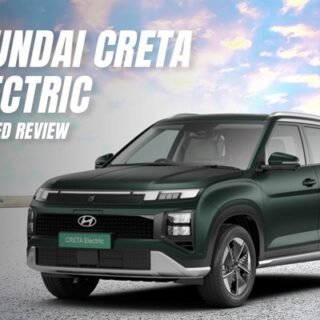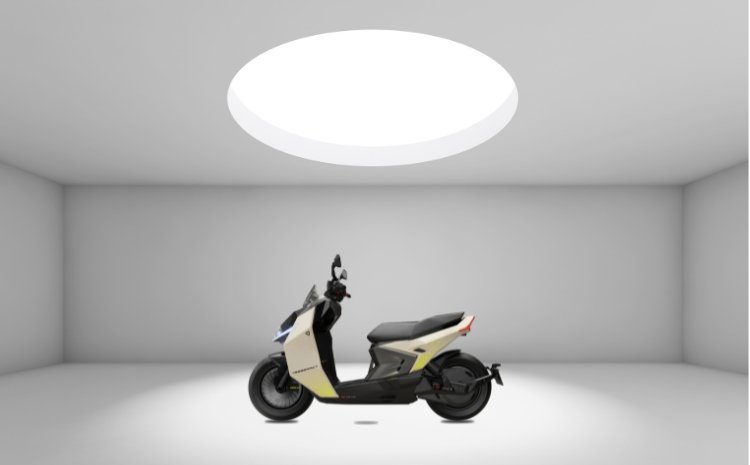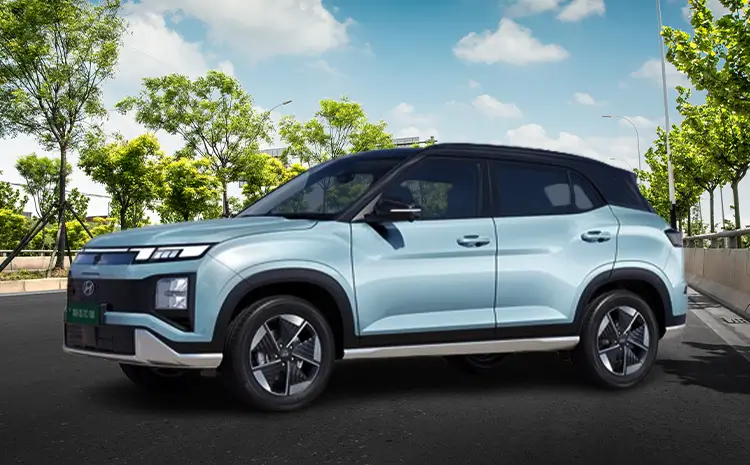As the new year began, the electric version of India’s most popular SUV, the Hyundai Creta Electric, arrived. With all of the Creta’s excellent traits (spacious, feature-rich, modern, and premium), a few new features, and an enhanced design, the electrified Creta stands out not only as an EV but also as a potential upgrade over its ICE (internal combustion engine) equivalent.
It’s a compact electric SUV that competes with the Tata Curvv EV, Maruti Suzuki e-Vitara, and Mahindra BE 6. After driving it and witnessing what Hyundai has accomplished, we can easily claim that this is the best Creta on the market. Here is why.
Exterior Design and Aerodynamics
At first glance, the Hyundai Creta EV may remind you of its petrol and diesel siblings. But it carries enough unique touches to stand out as a modern EV.
- The front bumper gets a pixelated design that gives it a high-tech look.
- A smart charging flap is neatly hidden and opens automatically when cooling is required, improving airflow.
- You’ll notice satin metal accents and signature LED DRLs with a connected design that looks premium.
- There’s also a 360-degree camera integrated into the front part of the ADAS safety package.
- The aerodynamics are well thought out, helping the EV glide through the air more efficiently.
Side Profile – Wheels, Tyres, and Dimensions
From the side, the Creta EV retains most of its original silhouette, but look closer, and you’ll see the EV-specific changes.
- It comes with 17-inch aero-optimized alloy wheels designed to reduce drag.
- Low rolling resistance tyres help improve energy efficiency.
- The dimensions are the same as the standard Creta, including 200mm ground clearance.
- However, because the battery pack is mounted low, you should be a bit cautious while driving over tall speed breakers, especially with a full load.
Rear Design – Sleek Yet Familiar
The rear end keeps things neat and familiar.
- Connected LED taillamps, a roof spoiler with an integrated stop lamp, a shark fin antenna, and a rear wiper/washer are all included.
- The lower bumper continues the pixelated styling, and of course, there’s no exhaust pipe—this is a true electric vehicle.
Interior – Dashboard and Cabin Highlights
Step inside, and you’ll find a cabin that blends the familiar with the futuristic.
- A new steering wheel features paddle shifters, now used to control regenerative braking.
- The gear selector has moved to the steering column, opening up more space in the centre console.
- You also get cooled storage areas, including a cooled glovebox.
- USB-C ports, a wireless phone charger, and a floating center console with controls for drive modes, the electronic parking brake, and a 360° camera toggle are included.
Infotainment and Comfort Features
The Creta EV uses a dual-screen layout similar to the ICE version but features a new, more modern UI, much like what we’ve seen in the Alcazar.
- The center panel has fewer physical buttons, making it look sleek and clean.
- Front ventilated seats offer added comfort, and the driver’s seat gets power adjustment with a memory function.
- The upholstery is premium, and Hyundai has used some recycled materials, giving a subtle, eco-friendly touch.
- The only downside? It still doesn’t support wireless Android Auto or Apple CarPlay.
Rear Seat Experience
The wheelbase remains unchanged in the back, so legroom continues to be generous.
- Seat-back trays, cupholders, and ample space for gadgets are provided.
- The floor is slightly raised due to the battery, which may affect under-thigh support for taller passengers.
- Reclining rear seats with a 2-step adjustment let you get comfortable on long drives.
- Other highlights include rear sunblinds, AC vents, USB-C ports, and a large panoramic sunroof that makes the cabin feel airy.
Boot Space, Frunk, and Storage
Hyundai has ensured that the EV doesn’t compromise on practicality.
- Boot space remains at 433 litres, the same as the ICE version.
- There’s even a full-size spare wheel under the boot floor.
- A 22-litre frunk (front trunk) under the bonnet adds to the storage capacity.
Extra Feature – Vehicle-to-Load (V2L)
One of the standout features of the Hyundai Creta EV is V2L (Vehicle-to-Load) tech.
- A 3-pin socket is available under the rear seat.
- This lets you power small appliances or charge devices, making it perfect for camping trips or emergencies.
Battery Options and Powertrain
The Hyundai Creta EV will be available with two battery options: a 42 kWh and a 51.4 kWh. Both use NMC (Nickel Manganese Cobalt) battery chemistry, which offers better energy density compared to the LFP (Lithium Iron Phosphate) batteries used by some rivals. This means you can expect better range and performance from the Creta EV.
Key Specs
| Specification | 42 kWh Variant | 51.4 kWh Variant |
| Motor Type | IPMSM (Interior Permanent Magnet Synchronous Motor) | IPMSM (Interior Permanent Magnet Synchronous Motor) |
| Max Power Output | 99 kW (135 PS) | 126 kW (171 PS) |
| Battery Type | Liquid-cooled Lithium-ion | Liquid-cooled Lithium-ion |
| Battery Capacity | 42 kWh | 51.4 kWh |
| Driving Range (MIDC) | 390 km | 473 km |
| DC Fast Charging (10–80%) | 58 minutes | 58 minutes |
| AC Fast Charging (10–100%) | 4 hrs | 4 hrs 50 min |
The Verdict
Hyundai has created an EV that demonstrates that you don’t need flashy things to stand out by taking the design and functions of the ICE and improving on some of them. The electric Creta has all of the Creta’s wonderful traits, making it an excellent family SUV, but it also has its unique features.
The Hyundai Creta Electric is priced between Rs 18 lakh and Rs 24.37 lakh (ex-showroom), representing a price premium of roughly Rs 3 lakh over the ICE model. The price increase would be justified by its more premium design, greater features, and exciting performance.
If charging is not an issue for you, the Creta Electric is an excellent pick, and we’d even recommend it over the normal Creta. It has a tidy and clean look, a terrific feature list, plenty of power, and enough range for your daily drives. This is not just an excellent Creta, but the best Creta on the market.
About The Author
Neha Wagh
Neha is a tech enthusiast passionate about exploring the technology behind electric vehicles. She loves testing new features in bikes, scooters, and cars to stay updated in the EV world.















